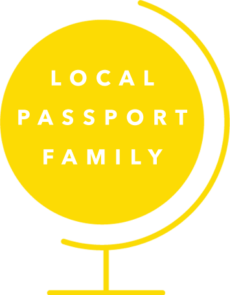Traveling with kids internationally can be so fun and also a bit overwhelming. There’s a lot to think about and take! I’m a big fan of packing minimally to limit stress (here’s our packing list) except when it comes to important documents. This is when you want to make sure you have not just everything you need, but some extras to help travel – especially when transiting – go as smoothly as possible.
Here are the documents I recommend taking along when traveling internationally with kiddos. I hope it’s helpful!

Passport for Travel with Kids
The number one most important document to have with you for every family member, including kiddos, is a passport. Before traveling, be sure to check the requirements at your destination – many places (including Schengen countries in Europe) require 6 months validity after the date of exit from that country. Many of these destinations also require that you have at least two blank pages remaining upon exit. So be sure to update your passports well in advance if needed! You can find current processing times here.
To keep all our passports organized, I really like this 8-person family passport holder. It’s RFID-blocking and has several zipper pockets and sleeves to keep all our documents in order.
Visas for Family Travel
In addition to a valid passport, many destinations require a visa to visit. Be sure to check the US Embassy site for the country you’re planning to visit to see if a visa is required, how much it costs, and how to obtain one.
Medical Documents
If your family has any medical needs at all – from allergies to medications to disabilities – it’s a very good idea to print out information about this and take it with you. This is really important for some prescription or even over-the-counter medications that may be illegal in other countries.
It can also be really helpful to look up the names of specific items (like medications or allergens) in the language of the country to which you’re traveling. You don’t want to get stuck trying to explain names in an emergency situation, and having this written down can make communication faster and easier.
US Embassy or Consulate Information
When traveling out of the country, it’s a good idea to write down the address and phone number of the nearest US Embassy or Consulate. This handy printable card is a great thing to remind you of what to bring and to write down that information.
I also highly recommend going through STEP enrollment (Smart Traveler Enrollment Program) prior to your trip. This is a free service that allows US-based travelers to register your trip with the nearest Embassy or Consulate.
International Driving Permit
If you’ll be doing any driving while out of the country, it’s a good idea to carry an International Driving Permit. Some countries don’t recognize a US driver’s license, and may check for this document. Fortunately, getting one is a relatively simple process that only costs $20. Here’s more information on how to apply. Be sure to check into rental vehicle insurance, as well (some credit cards have perks for this).
Global Entry Card
If you are enrolled in Global Entry, be sure to bring your card with you just in case. This can really expedite the customs process! Mobile Passport Control is another great option that doesn’t require an additional fee or pre-approval. (You can see our process of using Mobile Passport here.)
Consent for Travel with Minors
If you’ll be traveling as a solo parent or guardian with a child across international borders, be sure to take along a consent for travel with minors document. Many countries won’t actually check for this letter, but some foreign border officials will look for a notarized document with written consent from a second parent allowing you to take your child into their borders. (Your destination country’s embassy should have information on whether this is required, but it’s really just a good idea to take it along regardless.) According to usa.gov, the letter should say “I acknowledge that my son/daughter is traveling outside the country with [the name of the adult] with my permission.” Some countries are very strict about this, so it’s definitely better to have it and not need it, rather than to need it and not have it.
Here’s a FREE PRINTABLE CONSENT TO TRAVEL (or here’s another one) – fill it out and take it to a notary to sign and stamp.
If you have sole custody of your child, bring along custody paperwork showing this. To be extra safe, it’s a good idea to bring along a copy of the child’s birth certificate with your name on it, especially if you and your child have different last names.
Medical and Trip Cancellation Insurance
When traveling internationally, it’s really important to have a provision for any medical care you may need. You never know what may come up, especially in new circumstances, so it’s good to be prepared. Some employer healthcare programs cover international travel, so check into this option. Here’s more information about managing your health abroad.
In addition to this, you may want to consider trip cancellation/interruption insurance. This is something that some countries required during the height of the COVID-19 pandemic, so it’s good to check to be sure. It’s also just wise to have regardless in case plans change!
Immunization Records
Some countries require documentation of immunizations in order to enter. Some examples are vaccination against Sars-Cov-2, yellow fever (when traveling from certain countries), and more. Be sure you have documentation of vaccines for your entire family, as well as information on any medical needs/prescriptions, including things like prophylaxis if traveling to a malarial area. The Centers for Disease Control website has more information on what vaccines may be required or recommended for different destinations.
Travel Details: Itineraries, Flight Confirmations, Hotel Reservations, Etc.
Arrival customs forms often require information such as onward flight details, accommodations contact information, etc. It will make it easier on you if you have this stuff printed and handy! I also sometimes take screenshots of this type of information so it’s easily accessible in my phone photos app without having to pull out a bunch of paperwork.
Photocopies
Finally, it’s important to have photocopies of your documents available just in case anything happens to the originals. I highly recommend making two photocopies – keep one with you but in a separate place from your originals, and leave one home with a family member or friend. It’s good to include things like birth certificates, passports, visas, flight confirmations, hotels, and more, so that your locations are documented, as well.
There you have it! All the documents we take when flying internationally with kids. I always store these in a secure digital location in addition to having physical copies and photocopies. I hope this is helpful as you plan your own international trip with kids!











Very useful information about international travel documents for kids. I have noted them down and will use when planning a trip with my kids.
Thanks for providing useful information and practical tips on travel documents when travelling with kids. The valuable insights will help any US citizen to prepare essential documents when visiting any foreign country with their kids.